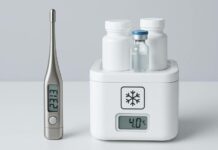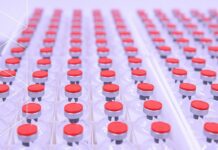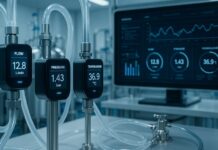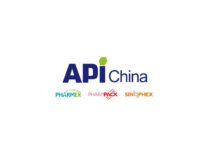Market for Pharmaceutical Robots Projected to Reach $426.8M by 2031
From small-scale manual production using simple tools to massive operations in today’s multimillion-dollar pharmaceutical industry, medication manufacture has changed dramatically throughout time.
Technological developments like robotics, artificial intelligence (AI), and the Internet of Things (IoT), which have substantially enhanced the efficiency, quality, speed, and adaptability of pharmaceutical manufacturing processes, are the reason Pharma 4.0 is emerging. 2.
Pharma 4.0 stands for what?
Industry 4.0 is the fourth industrial revolution connected with the implementation of sophisticated technologies transforming the production scene. Pharma 4.0 has seriously questioned established drug development business structures and batch methods. Pharma 4.0, as said above, entails the application of technologies such artificial intelligence, robotics, automation, computational modelling, and artificial intelligence that help to manufacture pharmaceutical products with low human involvement. 3
Pharma 4.0 has helped to significantly lower resource use. Inspired by a larger data density, the pharma sector created tailored pharmaceutical items fit for individualised therapy instead of the present one-size-fits-all approach. 4.0 Pharma 4.0 advances improved quality control and sustainable values.
Basic elements of Pharma 4.0
The following lists some of the main elements of Pharma 4.0:
Digitality
One of the main foundations of Pharma 4.0.4 is digitalisation combined with appropriate cybersecurity. IoT, a cyber-physical system made of well-coordinated computing devices, sensors, instruments, and equipment linked with a controlled network, is used by smart factories. Fifth
Considered the foundation of IoT, data digitalisation is the transformation of once manually created data into digital form. Data on supply chains—e.g., raw material variability—operation processes, operator job instructions, video-based training, and real-time monitoring has greatly enhanced decision-making in pharmaceutical businesses.
Real-time monitoring made possible by digital integration into an Internet of Things has transformed biosensor diagnosis. It has also opened the path for the creation of individualised medicine with ideal dosage.
Every unit of a useful IoT must be able to transmit and save data by being linked to the cloud. Pharmaceutical businesses can handle several data types—including manufacturing, clinical, genomic, patient, and supply chain—by means of cloud storage. Six
Authorised devices with an internet connection allow one to quickly access and examine this data.
In pharmaceutical manufacture, artificial intelligence (AI) is applied to forecast equipment maintenance and guard against manufacturing hazards, production downtime, and equipment disruption. 07 It makes pharmaceutical sector manufacturing processes better and more efficient.
Particular artificial intelligence systems allow processing vast and diverse sets. Two branches of artificial intelligence that significantly influence risk prediction and management are machine learning (ML) and artificial neural networks (ANN).
ML makes use of computers’ capacity to learn a task via data monitoring and statistical methods to infer broad knowledge from these data without outside stimuli.
ML algorithms are classified as supervised learning, unsupervised learning, and reinforcement learning depending on how input data is handled; each of these methods is applied in pharmaceutical production processes. For the biomanufacturing process, for instance, the ANN model is applied in risk-based analysis. Eighth
This method forecasts therapeutic medication pharmacokinetics and helps to uncover faults in complicated dynamic systems.
Technology and robotics
Manufacturing process simplification made possible by robotics and automation 07 By means of cloud-connected process analytical technology (PAT), complete process automation has been feasible as all process performance data may be captured.
Big data can then be turned into knowledge by artificial intelligence algorithms; this data offers understanding of the process and how manufacturing, quality, and safety of pharmaceutical items might be raised.
By essentially lowering the need for human involvement, robotics and automation have helped to lower manufacturing process mistakes.
Ad advantages of Pharma 4.0
There are various advantages Pharma 4.0 has for pharmaceutical corporations. Four Here are several important advantages:
- Pharma 4.0 emphasises on using technologies providing real-time monitoring of pharmaceutical production processes. This approach guarantees rapid identification and resolution of manufacturing problems, hence increasing production efficiency.
- Product quality: Pharma 4.0 provides early manufacturing process quality issue identification. Technologies provide consistent product quality.
- Pharma 4.0 provides the gathering and analysis of individualised medical records, therefore supporting the development of customised or individualised treatment of patients.
- Pharma 4.0 technologies allow real-time supply chain monitoring, therefore improving tracking and maintenance of pharmaceutical product distribution and inventory.
- Pharma 4.0 supports the creation of reliable, high-quality, safer goods.
- Pharma 4.0 accelerates the drug research and manufacturing process by means of modern analytics and ML techniques. It thereby lowers the time needed for a medicine to go on the market.
Difficulties of Pharma 4.0
Pharma 4.0 calls for the application of several cutting-edge technologies as well as overcoming logistical and legal obstacles. Most of the developments are related to developing technologies supporting autonomous manufacturing systems with high process control and quality management. Automation guarantees constant product supply and less product variability.
Lack of industry precedent, great expense of adopting modern technology, and perceived regulatory uncertainty are the main obstacles preventing or postponing the application of advanced technologies. Moreover, great institutional knowledge of current platform technologies causes resistance to adopt a new one.
Lack of regulatory precedence often forces businesses to use traditional methods even if over time technology developments could raise standards of quality. Various worldwide jurisdictions have various regulatory expectations, which makes filing difficult; nonetheless, the international regulatory convergence on modern manufacturing technologies has greatly lessened this regulatory uncertainty for manufacturers.
Most pharmaceutical companies nowadays have only started negotiating the world of “big data.” Large volumes of unstructured data need to be converted into ordered information using reliable artificial intelligence models. One of the main technological difficulties of Pharma 4.0.2 is figuring out and explaining the intent of data.
Lack of proper training and inadequate experience could impede sustainable development in the pharmaceutical supply chain. Automaton replacement of the labour could affect employment possibilities.
Conclusion
Finally, technical developments have propelled the transformation of pharmaceutical manufacture from hand, small-scale production to mass, automated operations in the business. An expansion of Industry 4.0, Pharma 4.0 combines technologies including artificial intelligence, IoT, robots, and automation to transform manufacturing and medication development.
Personalised medication, better product quality, and increased efficiency have all come out of this change. Adoption of Pharma 4.0 does, however, present difficulties like regulatory complexity, expensive expenses, and the necessity of knowledge. Pharma 4.0 has enormous potential for the direction of pharmaceutical manufacture notwithstanding these challenges.


















